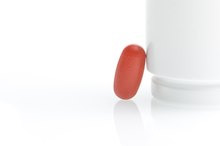Normal Ferritin Levels for Children
Ferritin levels are indicated on a laboratory test that indirectly measures the amount of iron in a patient's body 3. Normal ferritin levels change as children age, but they typically fall between 6 and 55 ng/mL. Abnormal ferritin levels can indicate imbalances in iron metabolism that happen with problems like anemia.
Significance
Ferritin levels are one of many things a physician can test to assess iron metabolism in a patient. Ferritin is a protein that binds iron, and therefore this test, much like many iron tests, is an indirect measurement of iron in the body 3. Other iron tests that are typically ordered with ferritin to give an overview of iron metabolism include hemoglobin, serum iron and total iron binding capacity.
Normal Range
Low Ferritin in Children
Learn More
The normal range of ferritin in children increases as they age. In children between the ages of 1 and 5 years, the normal range is 6 to 24 ng/mL. In children between 5 and 9 years of age, the normal range increases to 10 to 55 ng/mL. These levels continue to increase into adulthood, at which point they can be up to 200 ng/mL.
- The normal range of ferritin in children increases as they age.
Considerations
Despite the normal range of ferritin levels, the absolute ferritin measurement still indicates how much iron is in the child's body. A child with a ferritin measurement in the lower end of the normal range has less iron than a child in the upper end of the normal range. A child who's levels fall anywhere within the normal range has enough iron to be healthy. However, it is important to track ferritin levels over time for a child who has known iron metabolism problems so that an individual normal level can be established.
- Despite the normal range of ferritin levels, the absolute ferritin measurement still indicates how much iron is in the child's body.
Procedure
What Is a Normal Iron Level in a Toddler?
Learn More
The ferritin test requires blood to be drawn the from the child and sent for testing 3. In adults and older children, blood will typically be drawn from a vein with a needle. In younger children, a lancet may be used to quickly puncture the skin and collect enough blood for the test. While abnormal ferritin levels can be associated with iron metabolism problems, they can also be cause by non-associated reasons, such as use of certain medications. For this reason, a child who is on other medication may be directed by a physician to stop taking it before the test.
- The ferritin test requires blood to be drawn the from the child and sent for testing 3.
- For this reason, a child who is on other medication may be directed by a physician to stop taking it before the test.
Benefits
The benefits to a ferritin level test in children is to help identify iron metabolism disorders 3. For example, a low ferritin level could help diagnose iron-deficiency anemia, whereas a high ferritin level is essential to a diagnosis of hemochromatosis, which is an increase in total body iron. Using this test along with other iron metabolism tests, a physician can pinpoint the problem with iron metabolism and start the appropriate therapy.
Related Articles
References
- Medline Plus: Ferritin
- Iron Disorders Institute: Tests to Determine Iron Levels
- Lab Tests Online: Ferritin - The Test
- American Association for Clinical Chemistry, Ferritin
- UCSF Medical Center, Medical Tests: Ferritin
- Daru J, Colman K, Stanworth SJ, et al. Serum ferritin as an indicator of iron status: what do we need to know? Am J Clin Nutr. 2017;106(Suppl 6):1634S-1639S. DOI: 10.3945/ajcn.117.155960.
- Wang W, Knovich MA, Coffman LG, et al. Serum ferritin: past, present and future. Biochim Biophys Acta. 2010;1800(8):760-9. DOI:10.1016/j.bbagen.2010.03.011.
- Halland M, de Malmanche J. Interpretation of iron studies: a practical approach. Medicine Today. 2011; 12(7) 65-66.
Writer Bio
Erik Andrews began scientific and medical writing in 2004. His work as a second author on a research article appeared in the journal "Genetics" in 2005. His areas of expertise are the natural sciences, medical education and physical fitness. He earned a Master of Science in chemistry and a Bachelor of Arts in biochemistry, both from the University of Pennsylvania.









